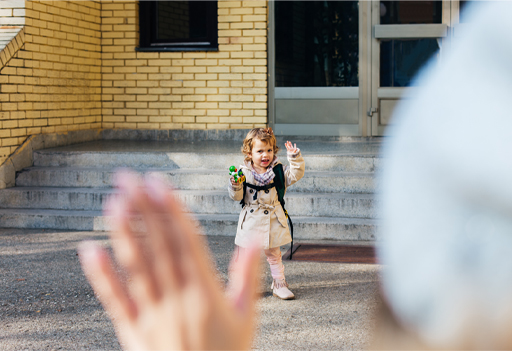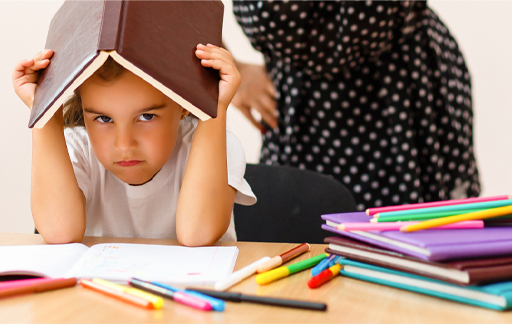5.4 ‘Triggers’ for children’s anxiety in early childhood and school settings
In the following section, you will look at some of the situations that can trigger anxiety for children when they are in educational settings.
Transitions and changes of routine: For many young children, moving from their home environment to an educational setting for the first time can be challenging but exciting. For some children, however, the experience may be overwhelming and difficult to accomplish. For example, children who do not have a stable family life may not be able to cope with the demands and expectations that are placed on them when they start school. Conversely, some children have a very supportive home and family environment and they struggle with starting school. They may not feel as emotionally prepared for the change as some other children. Behaviour that is acceptable at home may not be in a more formal setting. If young children are better prepared for such discontinuities, and the different expectations between the two environments are more openly discussed between parents, children and school staff, then more effective bridges between home and school can be created.
Children on the autistic spectrum may find changes to their normal routine problematic, as they will find it more difficult to feel they have a sense of control as to what is happening; consequently, starting school may ‘unbalance’ them. As a result, these children might increase some of their obsessive and/or repetitive behaviours as a way to block out the chaotic, unpredictable and ‘noisy’ environmental sounds and movements, as this can help them cope with the extra (unwanted) stimulation.
Both schools and carers have a responsibility to ensure that transitions happen as smoothly as they can, with good links made between home and school as early as possible. At times, for children with additional needs, these transitions require creative solutions (e.g. reduced hours to start with) and agile problem-solving (when things do not go as planned). Good practice to help children feel a greater sense of belonging and emotional security also highlights why the role of the key person in early years settings is so critical. You will look at this further in Session 5.
Bullying: Bullying, rejection from peers and teasing can be widespread wherever children engage in groups. It is not always easy for adults to understand the huge distress that bullying can cause children, especially when it involves what adults may see as low-level examples such as making fun of each other and intermittent teasing. However, when teasing becomes targeted and persistent, the child may feel extremely unhappy, especially when there is no escape from cruel and relentless judgements about themselves and the bullying goes unpunished. Thinking back to Session 1, where Bowlby’s theory of attachment was introduced, you looked at attachment and how children build relationships. The importance of children developing close, caring and positive relationships helps them to build up an effective internal set of ideas, or what has been called an ‘internal working model’ (Bowlby, 1969) of how they see themselves. If children receive consistently negative messages, this can feed into a child’s self-image of being less worthy and lead to them developing low self-esteem. The concept of internal working models will be looked at in detail in Session 3.
There are ways in which carers, schools and the local community can discourage bullying and encourage the growth of positive social relationships. You will look at this in more detail in Session 5.
Problems with the demands of school work: Even very young children can become frustrated, anxious or down if their attempts to meet the perceived standards of formal schooling (or what they think their parents want them to achieve) do not result in successful outcomes. They can then become so worried that ‘fear of failure’ stops them from completing work satisfactorily, or even ‘having a go’.
Often, the fears that a child has built up are worse than the reality of the situation (i.e. the anticipation is worse than the actual event). Helping the child to separate their thoughts and feelings from other people’s expectations can help. Also useful is working with the child to create achievable personal goals that they can monitor in some way themselves (e.g. using sticker charts).
Difficulties with teachers: In Session 3, you will explore how attachments between young children and significant carers evolve. Within these processes, teachers can be seen as potentially valuable secondary attachment figures as young children transition from home to school. However, sometimes children and teachers do not get on very well together and relationships can be strained or break down. In such circumstances, children might feel reluctant to go to school, develop psychosomatic illnesses (i.e. a mental health issue that manifests in physical form) to stay at home, growing highly anxious or becoming extra ‘clingy’ to parents/carers.
The key to resolving these issues is finding out from the child what it is about that particular teacher that is upsetting them, and seeing whether a more positive relationship can then be restored through negotiation between the family, teacher and child.
Socialising or group work: For some shy and anxious children, being part of a large group can be extremely intimidating. There can be the fear of being ‘shown up’ in front of others; therefore, these children might avoid answering questions in class. There can also be high levels of anxiety around performing tasks, even within a smaller group, for fear of ‘getting it wrong’ or ‘being made fun of’. Such anxiety is not just limited to the classroom but can be made even worse in a large playground situation at break times. The solution for some children is to walk around with the teaching assistant or teacher on duty and avoid taking part in games or activities with other children. Unless such social anxiety is tackled early on, and the child gradually supported to join in with other children using a step-by-step approach, then the avoidance can become so ingrained that any social situations can become extremely agonising as the child gets older.


